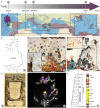Ancient Artworks and Crocus Genetics Both Support Saffron's Origin in Early Greece
- PMID: 35283878
- PMCID: PMC8913524
- DOI: 10.3389/fpls.2022.834416
Ancient Artworks and Crocus Genetics Both Support Saffron's Origin in Early Greece
Abstract
Saffron crocus (Crocus sativus) is a male-sterile, triploid flower crop, and source of the spice and colorant saffron. For over three millennia, it was cultivated across the Mediterranean, including ancient Greece, Persia, and other cultures, later spreading all over the world. Despite saffron crocus' early omnipresence, its origin has been the matter of a century-old debate, in terms of area and time as well as parental species contribution. While remnants of the ancient arts, crafts, and texts still provide hints on its origin, modern genetics has the potential to efficiently follow these leads, thus shedding light on new possible lines of descent. In this review, we follow ancient arts and recent genetics to trace the evolutionary origin of saffron crocus. We focus on the place and time of saffron domestication and cultivation, and address its presumed autopolyploid origin involving cytotypes of wild Crocus cartwrightianus. Both ancient arts from Greece, Iran, and Mesopotamia as well as recent cytogenetic and comparative next-generation sequencing approaches point to saffron's emergence and domestication in ancient Greece, showing how both disciplines converge in tracing its origin.
Keywords: #ArtGenetics; Crocus sativus; Genome; Minoan frescoes; cytogenetics; historical art; saffron.
Copyright © 2022 Kazemi-Shahandashti, Mann, El-nagish, Harpke, Nemati, Usadel and Heitkam.
Conflict of interest statement
The authors declare that the research was conducted in the absence of any commercial or financial relationships that could be construed as a potential conflict of interest.
Figures


References
-
- Abrishami M. H. (2004). Saffron, From Yesterday Till Today, an Encyclopaedia of Its Production, Trade and Use. Tehran: Amirkabir.
-
- Agayev Y. M. (2002). New features in karyotype structure and origin of saffron, Crocus sativus L. Cytologia 67, 245–252. doi: 10.1508/cytologia.67.245 - DOI
-
- Agayev Y. M., Fernández J. A., Zarifi E. (2009). Clonal selection of saffron (Crocus sativus L.): The first optimistic experimental results. Euphytica 169, 81–99. doi: 10.1007/s10681-009-9946-z - DOI
-
- Agayev Y. M., Zarifi E., Fernández J. -A. (2010). A study of karyotypes in the Crocus sativus L. aggregate and origin of cultivated saffron. in III International Symposium on Saffron: Forthcoming Challenges in Cultivation, Research and Economics 31 January 2010. Acta Horticulturae. 47–54.
-
- Alavi-Kia S., Mohammadi S., Aharizad S., Moghaddam M. (2008). Analysis of genetic diversity and phylogenetic relationships in Crocus genus of Iran using inter-retrotransposon amplified polymorphism. Biotechnol. Biotechnol. Equip. 22, 795–800. doi: 10.1080/13102818.2008.10817555 - DOI
Publication types
LinkOut - more resources
Full Text Sources

